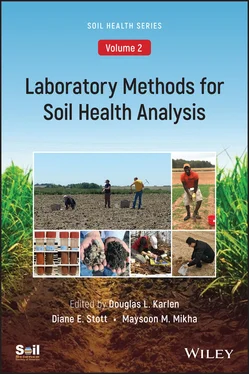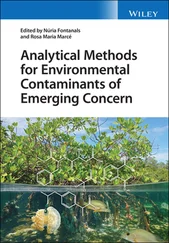Laboratory Methods for Soil Health Analysis, Volume 2
Здесь есть возможность читать онлайн «Laboratory Methods for Soil Health Analysis, Volume 2» — ознакомительный отрывок электронной книги совершенно бесплатно, а после прочтения отрывка купить полную версию. В некоторых случаях можно слушать аудио, скачать через торрент в формате fb2 и присутствует краткое содержание. Жанр: unrecognised, на английском языке. Описание произведения, (предисловие) а так же отзывы посетителей доступны на портале библиотеки ЛибКат.
- Название:Laboratory Methods for Soil Health Analysis, Volume 2
- Автор:
- Жанр:
- Год:неизвестен
- ISBN:нет данных
- Рейтинг книги:3 / 5. Голосов: 1
-
Избранное:Добавить в избранное
- Отзывы:
-
Ваша оценка:
- 60
- 1
- 2
- 3
- 4
- 5
Laboratory Methods for Soil Health Analysis, Volume 2: краткое содержание, описание и аннотация
Предлагаем к чтению аннотацию, описание, краткое содержание или предисловие (зависит от того, что написал сам автор книги «Laboratory Methods for Soil Health Analysis, Volume 2»). Если вы не нашли необходимую информацию о книге — напишите в комментариях, мы постараемся отыскать её.
Analyzing, comparing, and understanding soil health data Soil Health, Volume Two: Laboratory Methods for Soil Health Analysis
Laboratory Methods for Soil Health Analysis, Volume 2 — читать онлайн ознакомительный отрывок
Ниже представлен текст книги, разбитый по страницам. Система сохранения места последней прочитанной страницы, позволяет с удобством читать онлайн бесплатно книгу «Laboratory Methods for Soil Health Analysis, Volume 2», без необходимости каждый раз заново искать на чём Вы остановились. Поставьте закладку, и сможете в любой момент перейти на страницу, на которой закончили чтение.
Интервал:
Закладка:
Systematic sampling involves selection of predetermined sampling points, typically in a grid‐ or transect‐like pattern across the sampling area ( Table 2.3). Use of fixed sampling points simplifies sampling, with the added advantage of being able to return to the same point in the future. The data are amenable to spatial analyses (e.g., geostatistics) which can be used to identify a range of soil properties within a site (Dick et al., 1996). Use of systematic sampling is best suited for soil mapping when knowledge of the site is limited but resources are abundant.
Caveats associated with systematic sampling include bias based on grid selection. If there are large distances between sampling points, nuances in soil condition that would be detected at finer scales can be missed. Furthermore, systematic sampling may also sacrifice sampling efficiency (e.g., sampling by stratified zone) because points are selected in an established pattern. Accordingly, systematic sampling may be less cost effective than other designs.
Composite Sampling
Composite sampling can increase sampling accuracy and reduce analytical costs. Briefly, it involves collecting several homogenous samples in an area surrounding a sampling point and combining those samples into a single bulk (or composite) sample (Dick et al., 1996). For effective composite sampling, it is essential that each sub‐sample contributes equally and that there are no interactions among sub‐samples (Boone et al., 1999). Moreover, all sub‐samples must be collected from the same soil type and depth to be homogenous.
Composite sampling can be used with any of the above sampling designs, although it is less suited to systematic sampling because of the fixed sampling point constraints. Also, since multiple sub‐samples are combined and mixed, compositing samples in an area with a wide variation in physical disturbance should be avoided.
Sampling Depth
Selection of appropriate sampling depths is directly related to the evaluator’s goals. Evaluations of soil biological properties and processes as indictors of soil health, nutrient availability for plant growth, or profile carbon stocks will each require sampling at different but context‐appropriate depth increments. The selection of sampling depth increments must also consider soil forming and/or management‐induced changes, such as depth of tillage, to ensure important features are detected (Wienhold et al., 2006). Furthermore, since variability of some soil properties increases with depth, sampling intensity and the number of depth increments needed to detect differences among treatments or over time will vary by location (Kravchenko and Robertson, 2011). Selecting an appropriate number of depth increments requires a reasonable understanding of how variable a site is, how sensitive the indicators are, and the implications of over‐ or under‐estimating the correct value.
Two common sampling strategies are to use genetic horizons or uniform depth increments. Sampling by horizon is well‐suited for sites under native vegetation, where soil forming processes are readily evident throughout the profile due to distinct differences in morphology (i.e., texture, structure, color). Soils with distinct organic horizons benefit from this approach, because layers of surface litter are generally not amenable to fixed increment sampling (Soil Survey Division Staff, 2017). Sampling based on genetic horizons can significantly reduce observed variation throughout the profile (Boone et al., 1999), but requires knowledge of soil taxonomy.
Uniform depth sampling is distinctly different from horizon sampling because every increment starting at the soil surface is fixed (e.g., 0–5, 5–10, 10–20, 20–50, and 50–100 cm). This process facilitates consistency in sample collection across multiple sites, among different sampling crews, and over time (Boone et al., 1999). There is also less concern about biases associated with sampling depth provided the increments meet assessment objectives and accurately account for site characteristics and management attributes. Sampling by uniform depth increment also allows evaluators to know how many samples will be collected at the beginning of a project. Knowing this is beneficial for budgeting and for planning labor requirements (Boone et al., 1999).
One caveat associated with uniform sampling is the potential to miss important profile differences, especially if depth increments are large (e.g., ≥30 cm). Uniform sampling can also be problematic during near‐surface assessments if soil properties are strongly stratified with depth (Bowman and Halvorson, 1998). Failure to adjust sampling depth for near‐surface stratification can result in misleading management recommendations (Reeves and Liebig, 2016). Therefore, if near‐surface stratification is suspected, using small depth increments for the top 30 cm of the soil profile is recommended.
Conversely, a distinct advantage of uniform sampling is the opportunity to quantify soil bulk density. In addition to being a useful measure of soil physical condition, soil bulk density enables conversion of concentration data to a volumetric basis, thereby permitting expression of results on an area basis for a given depth increment (Dick et al., 1996). Soil bulk density values are also essential for calculating nutrient stocks using the “equivalent soil mass” method (Ellert and Bettany, 1995). This method accounts for differences in genetic horizon thickness and/or soil bulk density differences among treatments by calculating a standard soil mass before computing nutrient stocks.
Timing and Frequency of Sampling
Appropriate timing and frequency of sampling for soil health assessments will vary based on evaluator goals, indicators chosen, environmental conditions, management operations, and available resources. Evaluators must gauge tradeoffs associated with quantifying seasonal variability versus conducting an assessment at a single point in time. If done appropriately, the latter sampling option would select a time guided by knowledge of seasonal and/or annual variability and the timing of management operations. As shown by previous soil health evaluations, selecting an optimal sampling time is difficult (Wuest, 2015; Pikul et al., 2006; Mikha et al., 2006; Wienhold et al., 2006). Accordingly, sampling time decisions should be based by assessment objectives, recognizing that both management disturbances and environmental conditions can lead to misleading outcomes if not properly accounted for.
It is also important to recognize that due to temporal variability in every soil health indicator, the benefit to cost ratio will be low if sampling occurs too frequently. Annual sampling may be desirable for questions focusing on biological indicators, but for long‐term soil health changes, sampling every three to five years or at the end of a recurring period inherent to the production system (e.g., following a crop rotation or grazing cycle) will generally be sufficient. It is also important to collect samples at approximately the same time of year or under similar weather patterns to minimize variation in soil water content and temperature (Dick et al., 1996).
Sample Collection, Processing, and Archival
After deciding to implement a soil health assessment, it is important to carefully consider and document every aspect of the experimental design, sampling protocols, and how the samples will be handled. Each set of protocols is inherently project‐specific, underscoring the importance of thorough documentation for future reference. As a guideline for this chapter, protocols adapted from the USDA‐ARS GRACEnet (Greenhouse gas Reduction through Agricultural Carbon Enhancement network) project are listed below (Liebig et al, 2010). Additional guidelines can also be found in Boone et al. (1999) and Dick et al. (1996).
Читать дальшеИнтервал:
Закладка:
Похожие книги на «Laboratory Methods for Soil Health Analysis, Volume 2»
Представляем Вашему вниманию похожие книги на «Laboratory Methods for Soil Health Analysis, Volume 2» списком для выбора. Мы отобрали схожую по названию и смыслу литературу в надежде предоставить читателям больше вариантов отыскать новые, интересные, ещё непрочитанные произведения.
Обсуждение, отзывы о книге «Laboratory Methods for Soil Health Analysis, Volume 2» и просто собственные мнения читателей. Оставьте ваши комментарии, напишите, что Вы думаете о произведении, его смысле или главных героях. Укажите что конкретно понравилось, а что нет, и почему Вы так считаете.












